

BIOTYPE RESEARCH: ost
EXTRACTING ATTRIBUTES

Osteoporosis is a decaying condition in the bones which is an ever-increasing problem as the population ages. The bones are in a constant state of renewal, which allows the body to maintain bone density and structure integrity.

Inside, the bones contain cells the osteoclasts which break down bone tissue, and osteoblasts which produces new bone tissue using minerals such as calcium and phosphate from blood.
As we age, osteoporosis develops when bone resorption spreads and grows at a faster rate thus decreasing bone density. Viewed under a microscope, the absence of bone matter is larger hence the condition meaning, “porous bone . This deterioration weakens the bone structure and therefore weakening the human body.

This experiment will explore the rapid degradation of the bone induced by aging/time, as well as the distinctive form of the decayed bone matrix which produces a porous and fragile structure. This will be done through replicating the behaviour and attributes of osteoporosis.

UNDERSTANDING BIOTYPE: INVESTIGATION

EXPLORATION ost
SERIES A (PROCESS)



'Enzymatic browning' occurs in the skin of the banana which is an indicator of ripeness - more brown spots means the banana is becoming overripe. Bananas emit ethylene which causes the yellow pigment to decay. This decaying process occurs through time which will be seen in the spread of the brown spots on the banana skin similar to osteoporosis with large hollow spaces inside the bone.



Osteoporosis does not cause discoloration in the bone therefore Series A will consider the brown spots as an absence of matter representing the deterioration of the bone matrix. This will be observed through different variables/conditions which will influence the spread of the brown spots in a span of 6 days.





ENZYMATIC BROWNING
OSTEOPOROSIS
VARIABLES:
TEMPERATURE EXPOSURE TO LIGHT ETHYLENE CONCENTRATION
 DARK, IN A PAPER BAG, ROOM TEMPERATURE AMBIENT LIGHT, ON BALCONY DOOR, ROOM TEMPERATURE
DARK, IN A PAPER BAG, WITH RIPE BANANAS AMBIENT LIGHT, ON BALCONY DOOR, WITH RIPE BANANAS
DARK, IN A PAPER BAG, PLACED ABOVE FRIDGE DIRECT WARM LIGHT, ON TABLE, OVERNIGHT
DARK, IN A PAPER BAG, ROOM TEMPERATURE AMBIENT LIGHT, ON BALCONY DOOR, ROOM TEMPERATURE
DARK, IN A PAPER BAG, WITH RIPE BANANAS AMBIENT LIGHT, ON BALCONY DOOR, WITH RIPE BANANAS
DARK, IN A PAPER BAG, PLACED ABOVE FRIDGE DIRECT WARM LIGHT, ON TABLE, OVERNIGHT
SPECIMEN A
SPECIMEN B
CONDITION:
SPECIMEN C

CONDITION:
SPECIMEN D
SPECIMEN E
CONDITION:
CONDITION:
AGING AND SUSCEPTIBILITY TO DECAY TEMPERATURE EXPOSURE TO LIGHT ETHYLENE CONCENTRATION
SERIES A (OUTCOME)
CONDITION: CONDITION DARK, IN A PAPER BAG, ROOM TEMPERATURE AMBIENT LIGHT, ON BALCONY DOOR, ROOM TEMPERATURE AMBIENT LIGHT, ON BALCONY DOOR, WITH RIPE BANANAS DARK, IN A PAPER BAG, WITH RIPE BANANAS DARK, IN A PAPER BAG, PLACED ABOVE FRIDGE DIRECT WARM LIGHT, ON TABLE, OVERNIGHT DAY 6



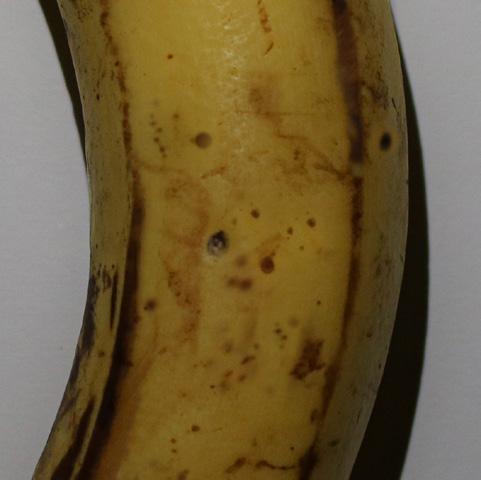




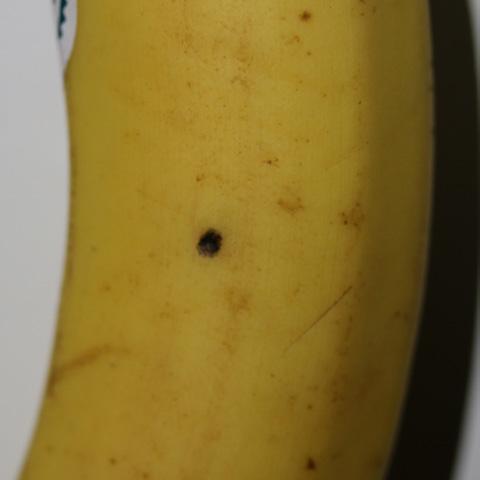











































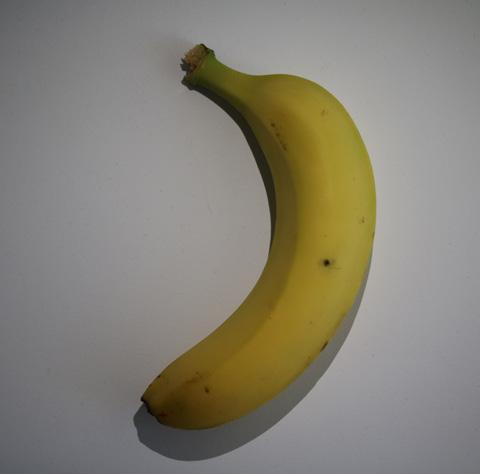


















SERIES A (OUTCOME)
SPECIMEN A
CONDITION:
Medium-sized brown spots has grown on the skin for the shortest amount of time. Condition is sufficient for the banana to ripen






Grown a large group of spots of varying sizes and has accumulated the most number of browning due to ethylene gas from ripe bananas being trapped in thepaper bag.
One of the quickest to ripen due to its proximity to heat. However, bruises are more evident than brown spots.
SPECIMEN D
CONDITION:
Had the least amount of browning spots. This is due to the room not achieving warm temperature as well as lack of ripening assistance from other ripe fruits
SPECIMEN B
CONDITION:
SPECIMEN C
CONDITION:
SPECIMEN E
CONDITION:
Although Specimen E is placed along with other ripe bananas, the ethylene gas is not being contained therefore less spots are visible
Also one of the quickest to ripen due to being exposed to warm temperature overnight. Growth of brown spots is constant.
SPECIMEN F
CONDITION:
B (PROCESS)
DECAY AND POROSITY
This series will observe the characteristic form of osteoporosis which are the large spaces in the bone matrix seen in a crosssection of an osteoporotic bone.


This bridges Series A exploration by using the extracted patterns of browning to inform the spots where the acetone, ('osteoclast'/decaying substance), will drop to the styrofoam (bone medium). The acetone rapidly dissolves the styrofoam block thus creating a porous form. SERIES
Initially, spraying acetone on styrofoam was chosen in the notion that it will create macro sizes of holes in the styrofoam block which should replicate the hollow spaces in the bone matrix. This however failed as acetone has a fast evaporation rate therefore mist will only touch the surface and not dissolve through.


The scale of degradation will be informed by various sizes of the extracted spots which determines the amount of acetone poured on a spot.
PREPARE MATERIALS. PREPARE STYROFOAM BLOCKS OF DIFFERENT THICKNESS
APPLY THE AMOUNT OF ACETONE DETERMINED BY 'SERIES A' OUTCOME PATTERNS
ACETONE DISSOLVES THROUGH STYROFOAM LAYER CREATING A POROUS NEGATIVE SPACE




B (OUTCOME)
'SERIES A' EXTRACTED PATTERNS DECAYED FORM DECAY DETAILS (POROSITY)












SPECIMEN A
SPECIMEN B
SPECIMEN C
SERIES B (OUTCOME)
'SERIES A' EXTRACTED PATTERNS



DECAYED FORM DECAY DETAILS (POROSITY)









SPECIMEN D
SPECIMEN E
SPECIMEN F







Series C will observe the absence of bone matter in an osteoporotic bone. Decay always imply a drastic change of matter from a state of soundness to its deteriorated form. However, osteoporosis is known as a 'silent disease' in which a person with this condition can only find out by suddenly having a bone fracture caused by an act as simple as coughing. This decay grows creating an illusion of a healthy bone on the outside while eating away the rest of the bone matter inside.
VARIABLES
STYROFOAM BONE MEDIUM - thickness/layers


This series will be observed through using the decayed form of the styrofoam blocks as a mold for plaster to extract the negative form. The molds should create various forms out of Series B which will determine the scale of degradation inside the bone despite a solid exterior surface

MAKING MOLD SERIES B MOLDS - wedging together molds of different decay forms
PREPARE STYROFOAM MOLDS FROM SERIES B BY APPLYING A SMALL AMOUNT OF OIL FOR EASIER REMOVAL

FILL MOLDS WITH PLASTER OF PARIS THROUGH POURING AND WEDGING MOLDS TOGETHER
DECAYED FORM OF PLASTER IS SET AND CURED
SERIES C (OUTCOME)
SPECIMEN A
Less amount of acetone forms a shallow depth of decay. Plaster extracted the decayed tecture of styrofoam.

SPECIMEN B
Height variation caused by different amounts of acetone used. Tip of the plaster narrows which suggests loss of reactivity between acetone and styrofoam



SPECIMEN C
Decayed form is uniform as acetone does not flow sideways. Styrofoam dissolves quickly thus another layer is added which creates a deeper form of decay.



SERIES C (OUTCOME)
SPECIMEN D SPECIMEN E SPECIMEN F
Layering of styrofoam medium creates varying height for decayed forms and extract textural details in that depth.


Styrofoam mold breaks and becomes stuck in the extracted form decreases the quality of decayed texture.
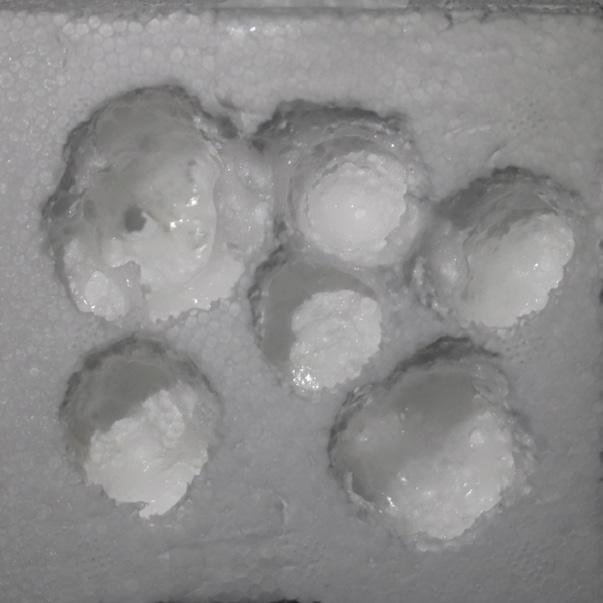


Form has extracted a larger decay in the top and a narrow base which shows that the acetone wasn't able to create a uniform flow through the layers.


SERIES C (OUTCOME)
SPECIMEN A + F
Wedging different styrofoam molds creates unusual forms. Evidence of using wedging is seen in the irregular seams of the decayed forms.
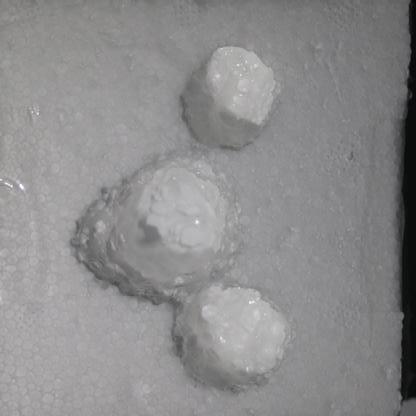


SPECIMEN B + C


SPECIMEN D + E + +
Irregular forms are extracted through wedging which varies to using a normal mold which would only produce a uniform decay form.
Irregularities of the mold is seen through the form which seems that some parts has been dissolved more and the other, less.





Replicating the bone condition 'osteoporosis' through the use of mediums such as bananas, styrofoam, and acetone, which has similar principles/process has presented limitations when exploring further into its main attribute which is porosity. By continuing the exploration of porous systems relative to 'osteoporosis' in the digital realm, I will be able to push through the limitations using softwares such as Houdini, Maya, and Blender by creating simulations that will closely replicate porosity and other attributes.

